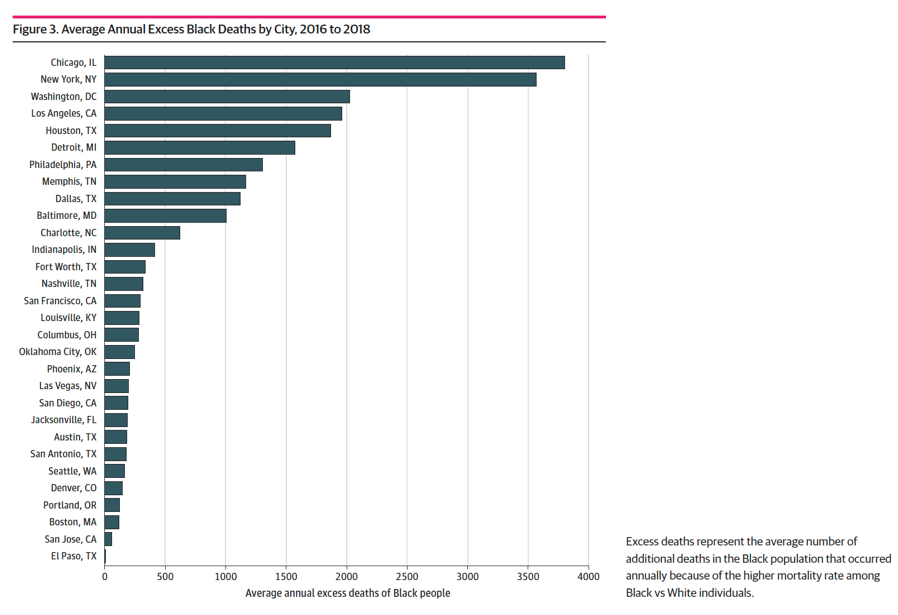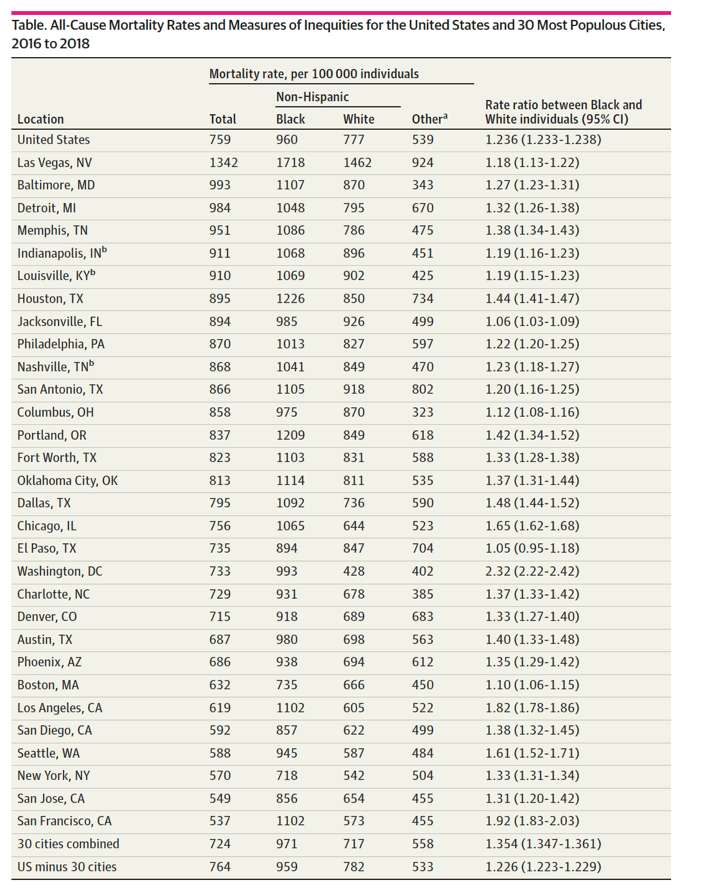| |
Excess Black Deaths PLWH & Higher Morbidity
|
| |
| |
Download the PDF here
1st study - The all-cause mortality rate among Black populations was 24% higher than among White populations nationally.
In 2016 to 2018, 74 402 excess Black deaths occurred in the United States annually because the mortality rate among Black populations was higher than that among White populations. At the city level, the number of excess deaths was highest in Chicago and New York
2nd publication below - - The Black:White mortality rate ratios (RR) indicate that the Black HIV mortality rate in the U.S. was over ten times the White rate in T1 and over nine times the White rate in T2 (Table 1). At the city level, all cities with sufficient data to calculate race-specific rates had statistically significant Black:White rate ratios at both time points.
Highest rates of mortality for blacks are in:
the worst performing cities were those with relatively high levels of overall mortality and high levels of inequity as measured by the Black:White mortality rate ratio (Figure 2). This quadrant included the following seven cities:
Jacksonville,
New York,
Baltimore,
Chicago,
Houston,
Charlotte, and
Philadelphia.
-------------------------------------
Morbidity Racial Inequity
Medicare PLWH: Blacks & Latinos 4-Fold Greater Risk - (06/14/21)
January 20, 2021

1st study - The all-cause mortality rate among Black populations was 24% higher than among White populations nationally
In every 1 of 30 cities in Table 1 below for 2019 every city had a higher mortality rate for Blacks than whites. Cities with the highest ratios of black to white mortality high Black mortality rates are: San Francisco, Washington DC, Baltimore, Jacksonville,FL, New York City, Dallas, Louisville…..see Table 1, Cities with lowest overall mortality included Portland OR, San Diego.

The study included 26 295 827 death records. In 2016 to 2018, all-cause mortality rates ranged from 537 per 100 000 population in San Francisco to 1342 per 100 000 in Las Vegas compared with the overall US rate of 759 per 100 000.
The all-cause mortality rate among Black populations was 24% higher than among White populations nationally (rate ratio, 1.236; 95% CI, 1.233 to 1.238), resulting in 74 402 excess Black deaths annually.
At the city level, this ranged from 6 excess Black deaths in El Paso to 3804 excess Black deaths every year in Chicago.
The US rate remained constant during the study period (average annual percentage change, -0.10%; 95% CI, -0.34% to 0.14%; P = .42). The racial inequities in rates for the US decreased between 2008 and 2019 (annual average percentage change, -0.51%; 95% CI, -0.92% to -0.09%; P =0.02).
Only 14 of 30 cities (46.7%) experienced improvements in overall mortality rates during the past decade. Racial inequities increased in more cities (6 [20.0%]) than in which it decreased (2 [6.7%]).
Conclusions and Relevance In this study, mortality rates and inequities between Black and White populations varied substantially among the largest US cities. City leaders and other health advocates can use these types of local data on the burden of death and health inequities in their jurisdictions to increase awareness and advocacy related to racial health inequities, to guide the allocation of local resources, to monitor trends over time, and to highlight effective population health strategies.
Racial Inequities
Racial inequities in mortality rates were assessed with rate ratios. In 2016 to 2018, the all-cause mortality rate among Black populations was 24% higher than among White populations in the United States (rate ratio = 1.236; 95% CI, 1.233-1.238). The rates among Black populations were significantly higher than those among White individuals in 29 of the 30 biggest cities (96.7%), with rate ratios ranging from 1.06 (95% CI, 1.03-1.09) in Jacksonville to 2.32 (95% CI, 2.22-2.42) in Washington, DC. In 1 city (El Paso), the mortality rates among Black and White populations were not significantly different (rate ratio = 1.05; 95% CI, 0.95-1.18). Overall, the racial inequities were greater in the 30 big cities than the United States as a whole.

Figure 2 shows that the US rate ratio between Black and White populations significantly decreased between 2009 and 2018 (average annual percentage change, -0.51%; 95% CI, -0.92% to -0.09%; P = .02). Two cities, Memphis and Philadelphia, also experienced significant annual
decreases in rate ratios (average annual percentage change, -1.70%; 95% CI, -2.71% to -0.69%; P = .005; and -1.59%; 95% CI, -3.14% to -0.02%; P = ...047, respectively).
In contrast, 6 cities experienced significant increases in inequities (San Francisco; Seattle; Chicago; Washington, DC; Las Vegas; and Portland). Portland’s increase in racial inequities (associated with increases in the rate among Black individuals) was especially pronounced (average annual percentage change, 3.58%; 95% CI, 2.28% to 4.90%; P < .001).
In 2016 to 2018, 74 402 excess Black deaths occurred in the United States annually because the mortality rate among Black populations was higher than that among White populations. At the city level, the number of excess deaths was highest in Chicago and New York, with more than 3500 excess deaths each (Figure 3). In contrast, El Paso had only 6 excess Black deaths, and San Jose had fewer than 100.
Download the PDF here
|
|
| |
| |
|
|
|